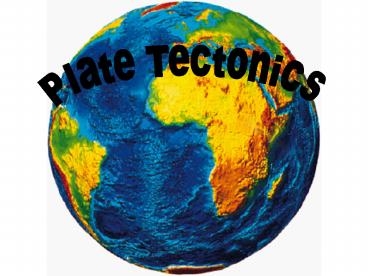Plate Tectonics - PowerPoint PPT Presentation
1 / 11
Title: Plate Tectonics
1
Plate Tectonics
2
Contents
- Plates and an introduction to plate boundaries
- Conservative Plate Boundaries
- Destructive Plate Boundaries
- Constructive Plate Boundaries
- Driving Mechanisms
3
Plates
- The Earths surface is divided up into rigid
plates which move relative to one another - The plate is the LITHOSPHERE, about 100 km
thick consisting of the CRUST (oceanic or
continental) and the UPPERMOST MANTLE. - Plates are rigid and are conductors of heat.
4
Distribution of Plates today
5
Plate Boundaries
These are ACTIVE boundaries (across which one
plate moves relative to the other).
6
This is not a plate boundary! Its a PASSIVE
CONTINENTAL MARGIN where continental crust thins
into oceanic crust.
7
Plate Boundaries
Destructive Margins (plates converge) e.g.
Pacific Rim, Andes Constructive Margins (plates
diverge) e.g. Mid-Atlantic Ridge, East Pacific
Rise) Conservative Margins (plates slide past on
another) e.g. San Andreas Fault.
8
Conservative Plate Boundaries
- Sometimes known as TRANSFORM BOUNDARIES
- Crust is neither created nor destroyed.
- Movement is STRIKE-SLIP.
9
Slip-stick produces many earthquakes, generally
shallow and with horizontal slips
10
Case Study San Andreas Fault
11
N.American plate
Pacific Plate

